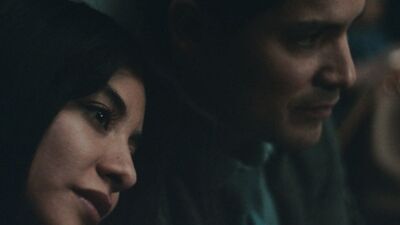How did you and/or Cherie Julander approach her character?
I think there is a practicality to the approach of USCIS officers. Ours in real life was cold, stern, calculated, by the book. I think about the people working in USCIS needing to detach themselves from the individual, and going off of what they see on the page. This is what I told Cherie to think about. I told her to imagine that years ago, when she first started this job, she really cared, and wanted to make a difference for aspiring immigrants and their families, but the years of having to bear bad news several times, had calloused her, and the slightest questioning of her own authority is a threat, so she has to put her foot down. She made it so Maria Luisa’s character was discouraged from digging deeper or questioning the reasoning behind the officer’s accusations. Cherie was able to deliver a pretty intuitively cold demeanor, not mean, but stern.

If you can speak to this, what was Alejandra Herrera’s experience like with her character?
Ale connected very much with the character. She mentioned in the past having to argue with US immigration officers for her eligibility to even just have a visa to come to the US. She also mentioned to me what went on in her mind when she was being optimistic for the future as Maria Luisa. She thought about the life Maria Luisa left behind in Mexico, and the opportunities she could have in the US. She also understood the relationship of the story from the beginning. No one really wants to leave their country, unless they have a good reason, and for Maria Luisa it’s her relationship with Jorge. Ale really understood that. Her potentially not being able to stay in the US also means she would not be able to be with Jorge. Ale also spent a good amount of time getting to know Lizde, whom the character is fundamentally based on, and she managed to pick up even some of her mannerisms and character, but in the end she made the character her own and delivered one of the best performances I’ve ever worked with.
Curiously, the film opens with a distorted shot of the couple in their car. I’m curious about yours and your cinematographer’s process of finding your way through a scene visually. What’s the overall experience you want audiences to have?
I am fascinated by this idea that looking through a glass, or a reflection, is a subjective vision. It’s filtered. I wanted to explore visually what the illusion of safety was with Maria Luisa and Jorge, so we looked at reflections, and shot through pieces of glass. Shooting through the side mirror of the car is meant to convey a sort of false reality. When Oscar Jimenez (my cinematographer) and I start looking through reference we begin looking at images thematically. One film we referenced was Dreyer’s The Passion of Joan of Arc, and that pretty much set the basis of what we wanted to work with because its frames express so much. We chose to shoot very tight, limiting the field of vision of the audience to get in the same headspace the characters are in, which is a limited perspective of their circumstances. It coincidentally helped us create claustrophobia and it really raised the tension during the interview. We added the glass elements we wanted to add, some filters and even scanned our finished film through Super 16 to add texture and grit to the image. I really like images that feel lived in and well worn.

